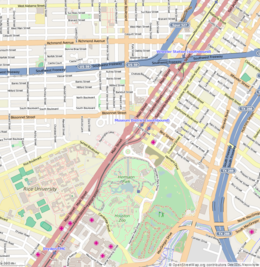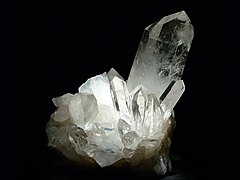Houston Museum of Natural Science
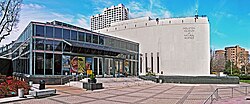 Southeast entrance to HMNS. | |
 | |
| Established | 1909 |
|---|---|
| Location | Houston, Texas |
| Type | Natural history museum |
| Public transit access | Museum District |
| Website | www |
TheHouston Museum of Natural Science(abbreviated asHMNS) is anatural history museumlocated on the northern border ofHermann ParkinHouston,Texas,United States. The museum was established in 1909 by the Houston Museum and Scientific Society, an organization whose goals were to provide a free institution for the people of Houston focusing on education and science. The museum complex consists of a central facility with four floors of natural science halls and exhibits, the Burke Baker Planetarium, the Cockrell Butterfly Center, and the Wortham Giant Screen Theatre (formerly known as the Wortham IMAX Theatre). In 2022, the museum received 1,520,000 visitors, making it seventh on theList of most-visited museums in the United States,and was the third most-visited U.S. science museum.[1]Much of the museum's popularity is attributed to its large number of special or guest exhibits.
History[edit]
The initial museum organization was called the Houston Museum and Scientific Society, Inc., and was created in 1909. The museum's primary collection was acquired between 1914 and 1930. This included the purchase of a natural-history collection assembled byHenry Philemon Attwaterand a donation from collector John Milsaps, the latter of which formed the core of the museum's gem and mineral collection.[2]First housed in Houston's city auditorium, the collection was subsequently housed in the Central Library for seven years, and then at a site in theHouston Zooin 1929. The museum's now wide-ranging education programs began in 1947 and, in its second year, hosted 12,000 children.[3]
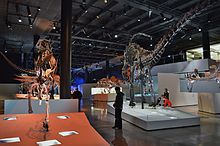
The museum was officially renamed the Houston Museum of Natural Science in 1960. Construction of the current facility inHermann Parkbegan in 1964 and was completed in 1969.[4]
By the 1980s, the museum's permanent displays included a dinosaur exhibit, a space museum, and exhibits on geology, biology, petroleum science, technology, and geography. In 1988, theChallenger Learning Centerwas opened in memory of theSpace ShuttleChallengercrew members that were lost during the shuttle'stenth mission.The center's aim is to teach visitors about space exploration. The Wortham IMAX Theatre and the offsite George Observatory were opened in 1989.
Museum attendance was more than one million visitors in 1990. HMNS trustees determined that new state-of-the-art facilities, additional space, and renovations to current exhibits were needed because of the increased attendance. Between 1991 and 1994, a number of exhibit halls were renovated and the expansion of the Sterling Hall of Research was completed. The Cockrell Butterfly Center and the Brown Hall of Entomology opened in July 1994.
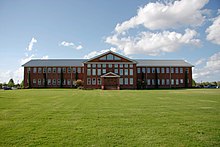
In March 2007, the museum opened the HMNSWoodlandsX-ploration Station, located in the Woodlands Mall. The facility was home to an interactive Dig Pit, where children could excavate a mockTriceratops,a variety of living exhibits, fossils, and minerals. The Woodlands location closed on September 7, 2009, less than a month before HMNS opened a satellite museum inSugar Land,Texas.[5]
HMNS celebrated its 100th year in 2009. During that year, the museum offered a multitude of family programs, lectures, free events, and kids' classes as part of the "Fun Hundred" celebration.[6]
On October 3, 2009, HMNS opened its satellite museum inTelfair,Sugar Land.[7]The building and surrounding land that became HMNS at Sugar Land was once part of theCentral Unit,aTexas Department of Criminal Justiceprison that had been unoccupied for several decades.
In March 2012, the Wortham IMAX Theatre was converted from 70 mm film to 3D digital and renamed the Wortham Giant Screen Theatre.[8]
In June 2012, HMNS opened a new 230,000-square-foot (21,000 m2) wing to house its paleontology hall, more than doubling the size of the original museum.Paleoartist,Julius Csotonyi,created fourteen murals based closely on concept drawings by HMNS Curator of Paleontology,Robert Bakker,for the new paleontology hall.[9][10]The Morian Hall of Paleontology contains more than 60 large skeleton mounts, including threeTyrannosaurus rexand three largeQuetzalcoatlus.
Permanent Exhibits[edit]
- TheFoucault pendulum,demonstrating the Earth's rotation. The length of the pendulum's cable is over 60 feet (18 m) long.
- Cullen Hall of Gems & Minerals,featuring a large exhibit of over 750 crystallizedmineralspecimens and raregemstones.
- Lester and Sue Smith Gem Vault,showcasing some of the most exquisite finely cut gems in jewelry.
- Farish Hall of Texas Wildlifeexhibits animals and wildlife native toTexas.The hall contains a video wall that displays the plants, animals and topography of the sevenbioticregions of the state.
- Evelyn and Herbert Frensley Hall of African Wildlife,a display oftaxidermiedanimals, including one of only twookapisexhibited in North America. Opening in 1969, the hall allows visitors to explore the sevenbiomesof the continent of Africa. Contains over 120 specimens, including 42 species of birds and 28 species of mammals are on display.
- Strake Hall of Malacology,with many specimens ofmollusks.
- Morian Hall of Paleontology,the largest paleontology hall in the United States. Contains over 60 major skeleton mounts, including threeTyrannosaurus rex,aDiplodocusand the most completeTriceratopsskeleton ever discovered. It also houses one of the largesttrilobitecollections in existence.Robert Bakkerserves as Curator of Paleontology.[11]
- John P. McGovern Hall of the Americas,showing more than 50 cultures worth ofpre-Columbianarchaeologicalartifacts.
- Welch Chemistry Hall,with interactive chemistry related displays and aperiodic table of elementswith a sample of each element.
- Wiess Energy Hall,with displays themed aroundenergetics,petroleum geology,andoil exploration.Renovated and expanded in 2017, the hall consists of 16 sections, including a working replica of an offshore drilling rig drill floor, a 15K resolution video depicting the history of energy, the "Geovator" (a simulated trip into the rock beneath Houston and back in time to the Cretaceous Period), the "Eagle Ford Shale Experience" (a simulated journey to Karnes County, TX, to experience the hydraulic fracturing of an oil well from inside the cracked rock), "Energy City," (a 1/150th scale white model depicting the entire energy value chain brought to life through projection mapping using 32 laser projectors), and Renewable and Future Energy Sources.
- Hall of Ancient Egyptopened in May 2013 and contains many millennia-old artifacts and features recreations of Egyptian temples and mummies from this ancient primary civilization.
- CockrellSundialopened in 1989 and is one of the world's largest sundials. It includes lenses on a special chrome ball on top of thegnomonso that at solar noon on theequinoxesandsolstices,sunlight shines through and casts an image of the Sun. Large sunspots can be seen by holding a white card in the beam and moving until it is focus.
- Earth Forum,which opened in 2002, is a computer-aided and hands-on exhibit teaching about Earth and its processes. The"Earth Update"software was developed byRice UniversitywithNASAfunding.[12]
-
Foucault Pendulumon display.
-
Quartzcrystal fromHot Springs, Arkansas,on display.
-
Denversaurusand the "Wyrex"Tyrannosaurusspecimen exhibited in the Morian Hall of Paleontology.
-
Triceratopsskeleton at the Houston Museum in a controversial running posture
Facilities[edit]


Burke Baker Planetariumpresents a range of science and astronomy shows. As of 2016, theplanetariumis equipped with the Digistar 5fulldomeprojection system. It is one of the first 8k planetariums in the United States.[13]
Originally opened in 1969 with a Spitz Space Transit Planetarium,[14]the Planetarium upgraded to anEvans & SutherlandDigistar 1 vector display in 1988, and was the first in the U.S. and third in the world to adopt multiple-projector digital image capability[15]using the Sky-Skan SkyVision system in 1998.[16]That allowed it to showfulldomemovies, many of which were created by HMNS staff. Since 2004 its outreach program, "Discovery Dome", takes the planetarium experience on the road, reaching over 40,000 students per year in classrooms and special events in portable digital domes.[17][18]
Cockrell Butterfly Center,abutterfly zoolocated in museum complex. Opened in 1994, the center is housed in a three-story glass building filled with tropical plants and butterflies. The center exhibits a large range of livebutterflies,including the migratorymonarchsand their tropical cousins. The Cockrell Butterfly Center was reopened in May 2007 after being overhauled to make the exhibit more interactive; there are now games for children and a live insect zoo in the Brown Hall ofEntomology.[19]
Wortham Giant Screen Theatre,a 394-seat theater presenting various educational films in 4K digital with advanced3Dtechnology on its 60 by 80 feet (18 by 24 m) screen.[20]
George Observatory,anastronomyobservatoryequipped with three domed telescopes, including a 36-inch (910 mm) Gueymard ResearchTelescopeand asolar telescope.The facility is located south ofSugar Land, TexasatBrazos Bend State Park.The observatory also houses a portion of the Challenger Learning Center for Space Science Education.[21]
References[edit]
- ^TEA-AECOM Museum Index, published June 2023.
- ^Wilson, Wendell E., Bartsch, Joel A., Mauthner, Mark. (2004).Masterpieces of the Mineral World: Treasures from the Houston Museum of Natural Science.The Mineralogical Record in association with Harry N. Abrams, Inc. p. 7.ISBN978-0810967519.
- ^"HMNS History".2008-09-30. Archived fromthe originalon 30 September 2008.Retrieved2022-02-23.
- ^Kleiner, Diana J., Holm, Patricia."Houston Museum of Natural Science".(2010, February 11). Texas State Historical Association, Retrieved 1 June 2014.
- ^"Woodlands".Archived fromthe originalon 2009-09-04.Retrieved2009-02-28.
- ^http:// hmns.org/see_do/hmns_at_one_hundred/the_fun_100.asp?r=1[permanent dead link]
- ^"Visit HMNS at Sugar Land".Archived fromthe originalon 2009-12-16.Retrieved2009-10-05.
- ^"Screentrade Magazine".
- ^Csotonyi, Julius, White, Steve. (2014).The Paleoart of Julius Csotonyi.Titan Books. pp. 10, 154.ISBN978-1781169124.
- ^White, Steve. (2014).Dinosaur Art: The World's Greatest Paleoart.Titan Books. p. 12.ISBN978-0857685841.
- ^"Curator's Corner".Archived fromthe originalon 2010-02-01.Retrieved2010-03-10.
- ^"Permanent Exhibits".Archived fromthe originalon 2009-10-14.Retrieved2009-02-28.
- ^"At Last, the Ultimate Planetarium".26 February 2016.
- ^"Making the Stars: A Brief History of the Burke Baker Planetarium".2016-02-02.Retrieved2019-07-11.
- ^Sumners, Carolyn, andPatricia Reiff,"Creating Fulldome Experiences in the new Digital Planetarium", NASA Office of Space Science Education and Public Outreach Conference, ASP Conference Series Volume 319, p. 374-376, 2004,ISBN1-58381-181-8.
- ^"CELESTIAL RENOVATION / Revamped planetarium brings space closer to home"(PDF).Houston Chronicle.1998-12-10.Retrieved2019-07-11.
- ^"Rice, HMNS pioneer portable," immersive "planetarium".2004-04-26.Retrieved2019-07-11.
- ^"Discovery Dome".Houston Museum of Natural Science.Retrieved2019-07-11.
- ^"Cockrell Butterfly Center | BEYONDbones".
- ^"Now Showing".Archived fromthe originalon 2009-04-12.Retrieved2009-02-28.
- ^"George Observatory".Archived fromthe originalon 2009-04-27.Retrieved2009-02-28.
Bibliography[edit]
- Csotonyi, Julius, and Steve White. (2014).The Paleoart of Julius Csotonyi.Titan Books.ISBN978-1781169124.
- Sumners, Carolyn, andPatricia Reiff,"Creating Fulldome Experiences in the new Digital Planetarium", NASA Office of Space Science Education and Public Outreach Conference, ASP Conference Series Volume 319, 2004,ISBN1-58381-181-8.
- White, Steve. (2014).Dinosaur Art: The World's Greatest Paleoart.Titan Books.ISBN978-0857685841.
- Wilson, Wendell E., Joel A. Bartsch, and Mark Mauthner. (2004).Masterpieces of the Mineral World: Treasures from the Houston Museum of Natural Science.The Mineralogical Record in association with Harry N. Abrams, Inc.ISBN978-0810967519.

